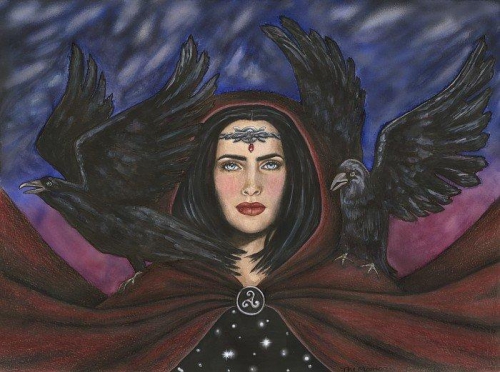The Morrigan (article from Linda-Lorien)
The Morrigan
The Morrigan is also known as the ‘Great Queen’ or ‘Phantom Queen’. She is known as a great goddess of war, destruction, sovereignty and magical transformation from Irish Celtic mythology. The root of her name is ‘Mor’ meaning monstrousness related to the ‘mare’ in nightmare’ and ‘rigan’ meaning ‘Queen’, therefore the ‘Monstrous Queen’. (Note” There is no evidence that the root of her name is linked to that of the goddess Morgana la Fay. Her name is from the Welsh root ‘morgan’ meaning the sea, related to water).
She is one of the Tuatha Dé Danann ("Tribe of the goddess Danu"), she is the daughter of Aed Ernmas and she helped defeat the Firbolg at the First Battle of Mag Tuireadh and the Fomorians at the Second Battle of Mag Tuireadh.
She is a protectress and empowers an individual – man or woman - to confront challenges with great personal strength, even against seemingly overwhelming odds. (Note: Roman chroniclers reported that Celts went into battle naked with women fighting alongside men, exposing tattoos to summon their magical forces).
She is a shape-shifter, her animals are the hooded crow (who warns of battle), the eel (who trips the unworthy), the wolf (who stampedes the battle charge), the cow (as a heifer who leads the battle charge, advises the rulers and guides their actions).
Like the Valkyries she can take a multiple form known as ‘Morrigi’
e.g: Badbh – battle crow goddess, predicting important person’s death – that cries and wails like the Banshee
Macha – horse goddess and sovereignty
Nemein –fairy spirit, goddess of war, ‘frenzy’
She is reported as being seen before a battle, as an old crone, washing the clothes of those that will die.
Positives: Like Athena she will judge the victor and create balance, transformation, achievement against the odds, conquering the will, making one’s fate. Her mating with the Daghda at Samhain heralds the earth hibernating for winter, a process of transformation, which is a necessary part of the seasonal year. Death is necessary for rebirth.
Her consort is the powerful Daghda and they come together at Samhain.
Properties: Goddess of War, Life & Death
Associated Sites: Battle-Fields; Plain of Muirthemne (near Dundalk, Co. Louth); River Unshin near Corann (she created the river by urinating)
Realm: The North (Land of the Dead)
Her element is earth. Her colours are black and red. She is a solar goddess sitting in the southern quarter.
Herbs: Mugwort
Trees: Yew, willow and blackthorn
Crystals: Clear quartz
Offerings: Ale, Crows Feather, Blood {Menstrual Blood}, raw red meat and red wine as well.
Other God form correspondences of destruction/vengeance/wrath
Badb (Celtic)
Bast (Egyptian)
Belili (Mesopotamian)
Durga (Hindu)
Erinys (Greek)
Hina (Polynesian)
Indrani (Hindu)
Itzpapalotl (Mesoamerican)
Kali Ma (Hindu)
Morrigan (Celtic)
Nemesis (Greco-Roman)
Nephthys (Egyptian)
Nirrti (Hindu)
Pele (Hawaiian)
Sekhmet (Egyptian)
A découvrir aussi
Retour aux articles de la catégorie Panthèon -
⨯
Inscrivez-vous au blog
Soyez prévenu par email des prochaines mises à jour
Rejoignez les 25 autres membres




